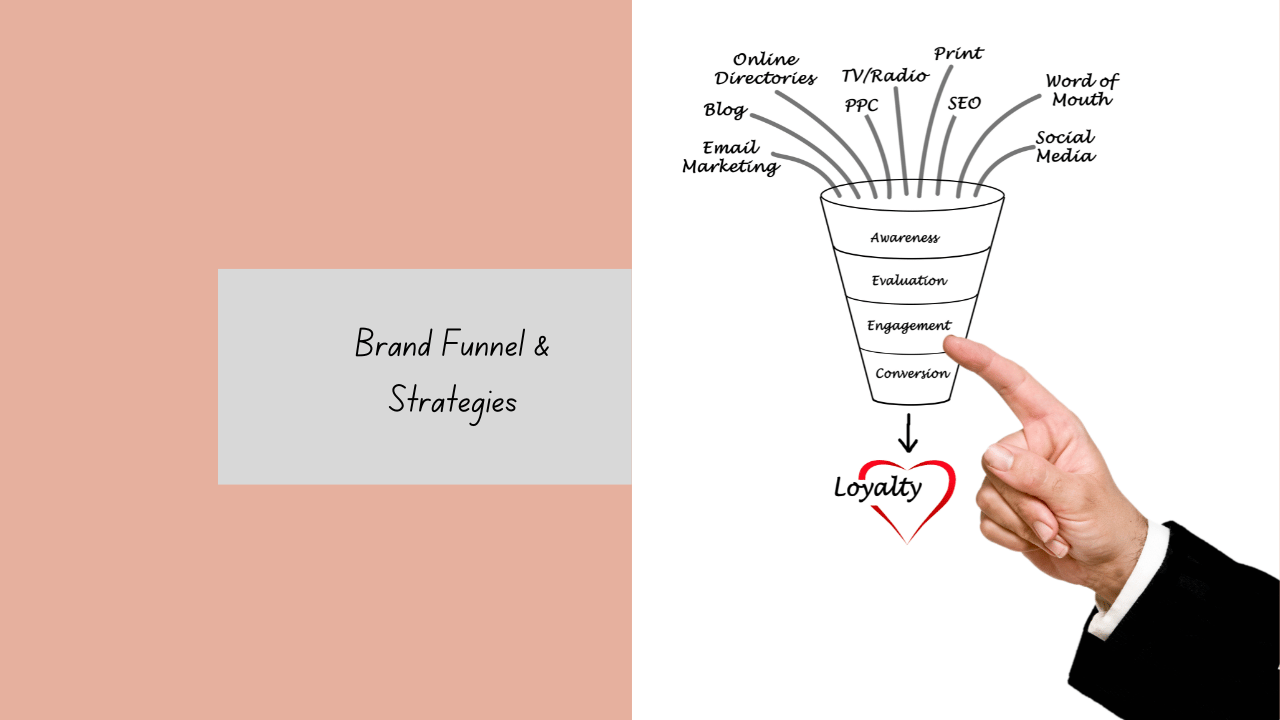Introduction to the Brand Funnel
Brand Funnel: Understanding the consumer’s journey from awareness to conversion is crucial for building a successful brand. The brand funnel, also known as the marketing or purchase funnel, is a model that illustrates the stages a consumer goes through when considering a product or service. It serves as a framework for marketers to identify and target potential customers at each stage of their journey, ultimately leading to conversion and brand loyalty.
The brand funnel is divided into several key stages, each representing a different level of consumer engagement and intent. These stages typically include Awareness, Consideration, Preference, Purchase, and Loyalty. By analyzing and optimizing each stage of the funnel. Marketers can develop more effective and targeted marketing strategies to drive brand awareness, engagement, and ultimately, sales.
We will explore the concept of the brand funnel in detail, discuss its importance in modern marketing, and provide tips on how to optimize each stage to maximize brand growth and profitability.
Awareness Stage of Brand Funnel

The first stage of the brand funnel is Awareness, where consumers become familiar with a brand or product for the first time. At this stage, the goal for marketers is to increase visibility and generate interest among the target audience through various marketing channels and tactics.
Effective strategies for the Awareness stage include:
- Content Marketing: Creating informative and engaging content that resonates with the target audience and provides value.
- Social Media Marketing: Leveraging popular social media platforms to reach a broader audience and increase brand awareness.
- Search Engine Optimization (SEO): Optimizing website content to rank higher in search engine results and increase organic traffic.
- Public Relations (PR): Generating media coverage and press releases to increase brand visibility and credibility.
By implementing these strategies, marketers can increase brand awareness and reach a wider audience, laying the foundation for the next stages of the brand funnel.
Consideration Stage of Brand Funnel
Once consumers are aware of a brand or product, they enter the Consideration stage, where they begin to research and compare different options before making a purchase decision. At this stage, the goal for marketers is to provide consumers with the information and resources they need to make an informed decision and choose their brand over competitors.
Effective strategies for the Consideration stage include:
- Content Marketing: Creating in-depth, informative content that addresses the needs and concerns of the target audience and showcases the benefits of the brand or product.
- Email Marketing: Sending personalized and targeted email campaigns to nurture leads and provide them with relevant information and offers.
- Retargeting Ads: Using retargeting ads to reengage consumers who have shown interest in the brand or product but have not yet made a purchase.
- Customer Reviews and Testimonials: Showcasing positive reviews and testimonials from satisfied customers to build trust and credibility.
By implementing these strategies, marketers can influence consumers’ purchase decisions and guide them towards choosing their brand over competitors.
Preference Stage of Brand Funnel

Preference stage, consumers have narrowed down their options and are ready to make a purchase. At this stage, the goal for marketers is to differentiate their brand from competitors and convince consumers to choose their brand over others.
Effective strategies for the Preference stage include:
- Unique Selling Proposition (USP): Clearly communicating the unique benefits and features of the brand or product that set it apart from competitors.
- Promotions and Discounts: Offering exclusive promotions, discounts, or incentives to encourage consumers to make a purchase.
- Social Proof: Showcasing endorsements from influencers, celebrities, or satisfied customers to build credibility and trust.
- Loyalty Programs: Implementing loyalty programs or rewards programs to incentivize repeat purchases and foster long-term customer relationships.
By implementing these strategies, marketers can influence consumers’ purchase decisions and encourage them to choose their brand over competitors, ultimately driving sales and revenue.
Purchase and Loyalty Stages
The final stages of the brand funnel are Purchase and Loyalty, where consumers make a purchase and become loyal customers of the brand. At these stages, the goal for marketers is to provide exceptional customer service, encourage repeat purchases, and foster long-term relationships with customers.
Effective strategies for the Purchase and Loyalty stages include:
- Customer Service and Support: Providing excellent customer service and support to ensure a seamless and enjoyable shopping experience.
- Personalized Marketing: Implementing personalized marketing strategies to reengage customers, recommend relevant products, and encourage repeat purchases.
- Customer Engagement and Community Building: Building a strong community of loyal customers through social media, forums, and other online platforms to foster brand advocacy and word-of-mouth marketing.
- Post-Purchase Communication: Sending thank-you emails, product recommendations, and exclusive offers to encourage repeat purchases and foster long-term relationships with customers.
By implementing these strategies, marketers can maximize customer lifetime value, drive repeat purchases, and build a loyal customer base, ultimately leading to sustainable growth and profitability for the brand.
Conclusion & Recap
The brand funnel is a crucial framework for understanding and optimizing the consumer’s journey from awareness to conversion. By analyzing and optimizing each stage of the funnel, marketers can develop more effective and targeted marketing strategies to drive brand awareness, engagement, and ultimately, sales.
key stages of the brand funnel include:
- Awareness: Increasing visibility and generating interest among the target audience.
- Consideration: Providing consumers with the information and resources they need to make an informed decision.
- Preference: Differentiating the brand from competitors and convincing consumers to choose their brand over others.
- Purchase: Providing exceptional customer service and encouraging repeat purchases.
- Loyalty: Fostering long-term relationships with customers and building a loyal customer base.
By implementing effective strategies at each stage of the brand funnel, marketers can maximize brand growth and profitability, ultimately leading to sustainable success and a strong competitive advantage in the marketplace.
